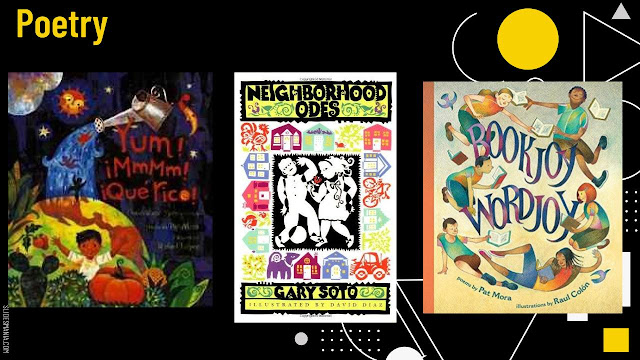Stories are magical, for both the young and old. Here you can find book reviews for specific age groups, topics, or learning experiences. There are also booklists and lesson ideas for educators, librarians, and families.
Search This Blog
Friday, May 28, 2021
Road Trip: an invitation in storytelling & geography
I Am Every Good Thing: introspection for elementary/middle schoolers
- Choose one slide to draw a picture of yourself and how you relate to the topic
- Use a Flipgrid topic to post your connection to the book.
- Create a stop-motion animation clip of an example of how you are every good thing.
- Design a PicCollage EDU page where you include a selfie & words to describe how you're every good thing, too.
- Make a book using drawings, cutout pictures or words from magazines, that show how you're every good thing. (This could be done electronically on Seesaw, too.)
- Write a poem like Barnes to give examples of how you are like the boy in the book.
- Add your name to a graffiti wall (butcher block paper or a whiteboard) and add symbols that show how you relate to the boy in the book.
Monday, May 24, 2021
Pawcasso: a lovable dog that divides & unites a community
Sunday, May 23, 2021
Accidental Lessons in Gender Inequity in Asia: Ruby's Wish & Ten Little Dumplings
Every year I share books that show celebrations of the Lunar New Year. This year I came across the picture book Ruby's Wish by Shirin Yim Leos (Bridges) and illustrated by Sophie Blackall and wanted to use it for reasons beyond how the family in the story celebrates.
After listening to the story, students used a template in Seesaw to respond to the questions. Students were shocked to learn about the gender bias against females and wanted to learn more. They wondered if this was still happening, what other countries did this exist, how people were trying to change that mindset worldwide.
Saturday, May 22, 2021
The One Thing You'd Save: what an answer reveals about a person
Friday, May 21, 2021
Take Back the Block: a middle grades activism tale
We Don't Eat Our Classmates: a lesson on individuality
What makes a good classmate? All students have opinions on this topic so that is what makes this kindergarten and first grade lesson work well at the start or end of the school year. Our students love dinosaurs but would they want one as a classmate?
I taught them the ASL sign for dinosaur and we practiced several times:
Lastly, students used the PicCollageEdu APP to take a selfie, add a background, and type their name and a tip on how to be a good classmate.
Wednesday, May 19, 2021
A "How-to" Unit for technical writing & storytelling for elementary/middle
I did this with 3rd graders and we had rich discussions, humorous moments of sharing personal observations and experiences, and an authentic audience awaiting one another's projects. There are numerous ways you can structure this lesson, but here is what I did and it worked well:
I began with telling them a personal story about how much I love avocados but they are tricky because if you buy too many at once they get ripe quickly and you must use them up or else they go funky. Students began sharing all of the ways that they relate to this, too. I asked them where I could find ideas on how to use up my avocados. Students suggested asking cooks, looking in books and on the internet. I told them that was listening to the radio and heard a story about using leftover food to reduce food waste and I played for them the video clip below:
Tuesday, May 18, 2021
78 Books to End the School Year & Kick-off Summer for elementary/middle

Monday, May 17, 2021
I Wanna Be Where You Are: YA music/dance/art rom-com
35 PRIDE Reads for elementary/middle grades
.jpg)
Less toxic masculinity, more community support
Ultraviolet by Aida Salazar is already one of my favorite books of 2024. When I was entering middle school, I read a lot of Judy Blume and...

-
During the 2018 Winter Olympics I was the school library media specialist at a middle school. I was looking for a way to drive more student...
-
Categories : roll the dice or draw a card with a color and the student picks a square from that row and teams can come up with examples, pa...
-
"How do you decide to what to read next?" This is a common question I get asked by my students, colleagues, even friends and fam...
-
September 15 - October 15 is Hispanic Heritage Month and although we need to share Latinx voices all year round, this is the month that we...
-
Our students want stories that encompass various people's perspectives. PRIDE month offers the chance to spotlight LGBTQIA+ people ...
-
Bibliotherapy is defined as " the use of literature to help people cope with emotional problems, mental illness, or changes in their l...
-
As the school year comes to a close, I always want students to reflect back on their progress academically, but also in other ways. When l...
-
The new school year is upon us and books are the greatest way to learn about students, build relationships and discuss characters, storyli...
-
As the school year winds down students want to continue to build memories with their teachers and classmates. A shared read can provide t...
-
I didn't envision my first blog post of 2022 being in honor of someone who has passed away , but here we are. The world lost an artist ...











.jpg)
.jpg)

.jpg)
























.jpg)
.jpg)
.jpg)
.jpg)
.jpg)
.jpg)
.jpg)
.jpg)
.jpg)




.jpg)
.jpg)


